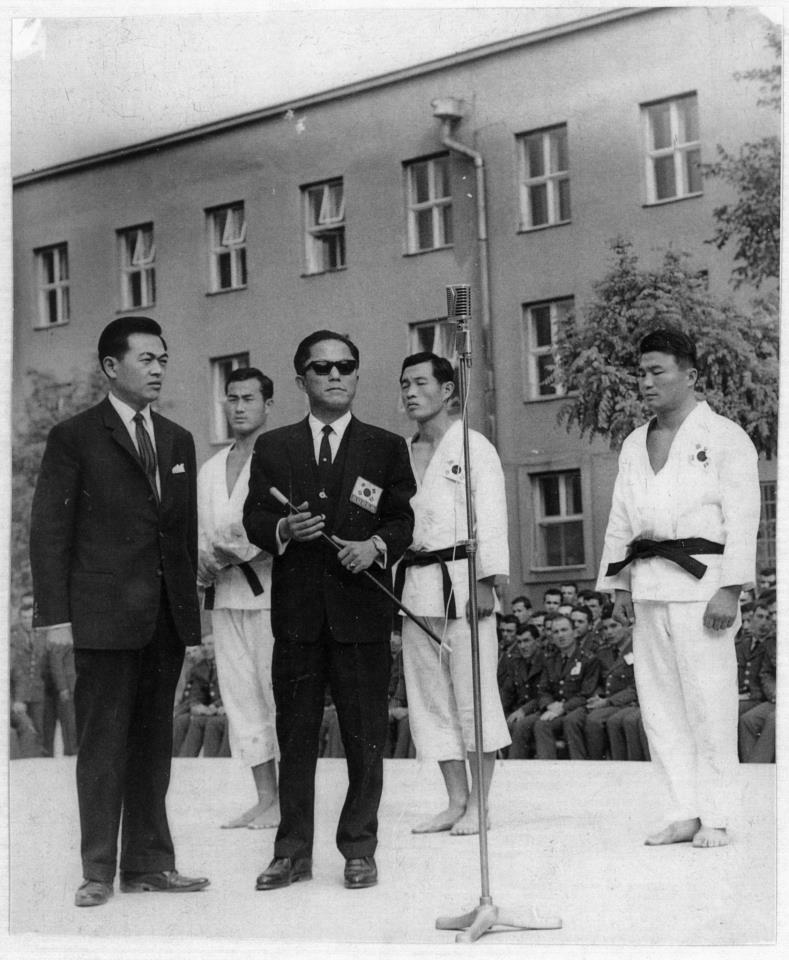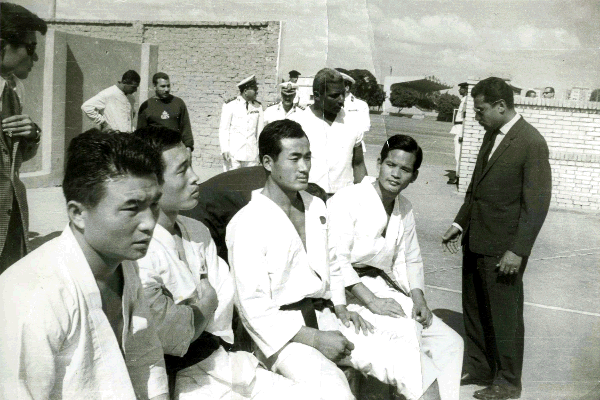In 1965, the South Korean dictatorship sent a group of martial artists on a world tour to show off a “new” martial art called “Tae Kwon Do,” but the art wasn’t new. A 40-second video clip from the tour in 1965 shows how similar the new art was to Karate: the two men who lightly sparred on that Oct. 24th day moved in a very Karate-like way. I’m not sure who named the video The Skillful Art of ‘Chop-Chop’, but judging from the faces of the 1,500 spectators in the basketball stadium in Munich, West Germany, people were impressed.
The event was called Karate World Elite in a banner in the video. There was no mention of Tae Kwon Do. In a world where Tae Kwon Do was Karate, and Karate was Jiu Jitsu, and Hapkido and Judo was sort of the same, too, and where martial artists regularly borrowed and stole from one other, you have to ask yourself how Korea’s leaders convinced so many people that Tae Kwon Do was uniquely Korean or even new.

TKD was based on Japanese Karate back then — but South Korean military leaders hid the Japanese parts, lied about TKD’s origins, and used martial arts to show off the power of Korea’s authoritarian government. A Korean general, Choi Hong-Hi, had stolen and plagiarized from Japan’s Shotokan Karate and made up the name “Tae Kwon Do” in 1955. He created the “International Taekwon-Do Federation” in 1966. In turn, the Korean Central Intelligence Agency (KCIA) stole and plagiarized from him, creating the “World Taekwondo Federation” in 1972, and went on to bribe officials to include TKD in the Olympics in later years. None of them wanted to admit that Korea’s martial art started with Karate from Japan, their historical enemy.
But, if anything, the awkward jumping techniques in the 1965 video show how TKD was trying to be different from Karate. In those days, Karate didn’t involve much jumping. By 1968, TKD also distinguished itself by featuring many “Foot Sparring Techniques” – a second big difference from Karate. For example, a one-minute clip from around 1968 shows Cho Sang-Min (a KCIA agent by the way) and another martial artist slowly demonstrate strikes and blocks using only legs.

Today, people are still obsessed with saying that their Karate is better than Tae Kwon Do, or our TKD is better than their Karate, or that Brazilian Jiu Jitsu or mixed martial arts is better than everything else. The arguments are ridiculous, and probably reveal more about ego and insecurities than anything. A great kick, punch or take-down is only as good as the person who does it. In any case, martial arts have borrowed from each other as long as people and cultures have mixed.
My book, A Killing Art: The Untold History of Tae Kwon Do (2016), gets into these issues, including details about the 1965 tour of Europe, the Middle East and Asia. General Choi led the team, dubbing it the Ace Demo Team, which included Han Cha-gyo, Jong-Soo Park, Joong-keun Kim and Jae-hwa Kwon. Carl Wiedmeier, owner of the Union Jiu Jitsu and Judo Schools C. Wiedmeier Karate Institute, in Munich, also joined them on stage. General Choi’s former right-hand man, Lieutenant Nam Tae-Hi, joined the Ace Team when they arrived in Singapore and Malaysia, where Nam was working for the KCIA.
So, the next time someone brags about how their art is the best, think of those videos from the 1960s – and about how everyone used to borrow and steal from everyone else. It was all about mixing and challenging then. It seemed more mixed martial arts than MMA today.
For detailed info about the similarities between Tae Kwon Do and Karate, See Udo Moenig’s essay, “The Evolutionary Process of Teakwondo Techniques through Competitionalization” (his unpublished master’s thesis from June, 2010).
Thanks to Shin-Gyu Kang for photos and videos from 1965. He got many of them from Grandmaster Kwon, Jae-Hwa. There dozens more photos on Kang’s site: http://www.taekwondo-europe.eu
Also, thanks to Stephen Doyle and JTFVideos1 for sharing the original 1968 video on YouTube. JTFVideos1 is from the Juntong Taekwondo-Do Federation.



Sorry, comments are closed for this post.